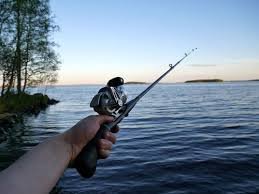Fish on Horn Pond
On Horn Pond, there are many different species of fish. The lake is stocked by both New Hampshire and Maine authorities. Horn Pond is inhabited by Brook Trout, Rainbow Trout, Brown Trout, Largemouth Bass, Smallmouth Bass, Eastern Chain Pickerel, Brown Bullhead, White Perch, and Bluegill.
Trout
Trout are a form of freshwater dwelling fish that grow to be anywhere from 9 to 25 inches long. They tend to live in the deeper parts of lakes, often amongst submerged objects. Trout typically eat small fish, crustaceans, insects, or their own eggs. Trout bury their eggs in gravel and baby trout, known as fingerlings, spawn between fall and spring. Trout are edible and regularly eaten. Their taste and texture vary depending on the diet of the fish but are often described as being similar to that of salmon.
There are two distinctions of trout- trout that are closely related to salmon and trout that are dubbed char. On Horn Pond, we have Rainbow Trout and Brown Trout, which are of the distinction closely related to salmon, and Brook Trout, which is a char. On Horn Pond, trout can easily be found and caught.
Rainbow Trout
Brown Trout
Brook Trout
Small & Large Mouth Bass
Smallmouth Bass are a sunfish that are characterized by their muscular body shape and golden-olive to dark brown coloring. They range from about 2 to 6 pounds and are about 12 to 16 inches long. They eat crustaceans (such as crayfish), amphibians, insects, smaller fish, insect larvae, and zooplankton. Smallmouth Bass are typically found among the rocky, sandier bottoms, closer to shore than trout. These fish are usually not eaten. They have a lifespan of 6-14 years. The Smallmouth Bass is very regularly caught on Horn Pond in shallow areas.
Largemouth Bass are a sunfish characterized by their olive-green color and large lower jaw. They are larger than the Smallmouth, with a length of 16 to 38 inches and weighing up to 22 pounds. They eat fish, including other sunfish, bluegill, trout, walleye, catfish, other bass, and crustaceans, worms, amphibians, and snakes. Juvenile Largemouth usually inhabit shallower waters, while the adults live in the deepest part of lakes. Largemouth Bass reach adulthood after a year and can live for 10-16 years in the wild. The Largemouth Bass is caught commonly on the lake, especially in highly vegetated areas.
Eastern Chain Pickerel
The Eastern Chain Pickerel belongs to the pike family. It is characterized by a dark chain-like pattern on its greenish sides. The Pickerel is a highly resilient fish that prefers vegetation cover. It eats small fish, snakes, worms, insects (often leaping out of the water to catch low flying bugs), and crayfish. On average, they are roughly 24 inches long, weigh 3 pounds, and live 8 years.
Brown Bullhead
The Brown Bullhead is a yellow-brown fish that belongs to the catfish family. It is characterized primarily by its 8 whisker-like barbels on its face. It prefers the bottom of lakes and rivers, where it is scarce during the day. It feeds on insects, leeches, worms, small fish, clams, and plants along the bottom during the night. They are anywhere from 8 to 20 inches in length, 1 to 8 pounds in weight, and live between 6 to 8 years.
White Perch
The White Perch is actually not a perch but a member of the bass family. It is silver with a highly domed back. It eats insects, crustaceans, small fish, fish eggs, and insect larvae. They weigh up to one pound, range from 7 to 19 inches in length, and can live up to 17 years. This fish species is classified as an aquatic nuissance, meaning that it often outcompetes other native species which can greatly decrease their population. Regulatory bodies ask that people not release more of this fish into the wild.
Bluegill
The Bluegill is a yellow-brown fish that belongs to the sunfish family and is closely related to perch. It is characterized by blue coloring under its chin and a black spot behind the ear area. They eat smaller fish, algae, fish and amphibian eggs, insects, and aquatic vegetation. They range from 12 to 16 inches in length, weigh up to 5 pounds, and live up to 11 years.
Fishing on Horn Pond
With shallow, weedy waters, deep water exceeding 30 feet, rocky and sandy coastlines, and plenty of vegetation, Horn Pond provides an excellent opportunity for fishing. With a plethora of variety in fish species that can be found in the lake and an abundance of overall fish (as the lake is stocked by both Maine and New Hampshire), our lake is a fisherman’s dream. While the dual stocking does not occur yearly, it occurs regularly enough to the lake’s supply of fish well intact.
Fishing Rules
To fish on the entirety of Horn Pond, you are required to possess a fishing license in both the state of Maine and the state of New Hampshire.
To keep our wonderful lake healthy and safe, fishing with either a lead sinker or hook is illegal. Current state law in New Hampshire states that it is prohibited to use lead sinkers and jigs with a weight of one ounce or less. All jigs shall not include lead fishing items including but not limited to lead core line, spinnerbaits, buzzbaits, spoons, poppers, plugs, or flys.
To learn more about the fishing laws, visit:
https://www.maine.gov/ifw/fishing-boating/fishing/index.html












